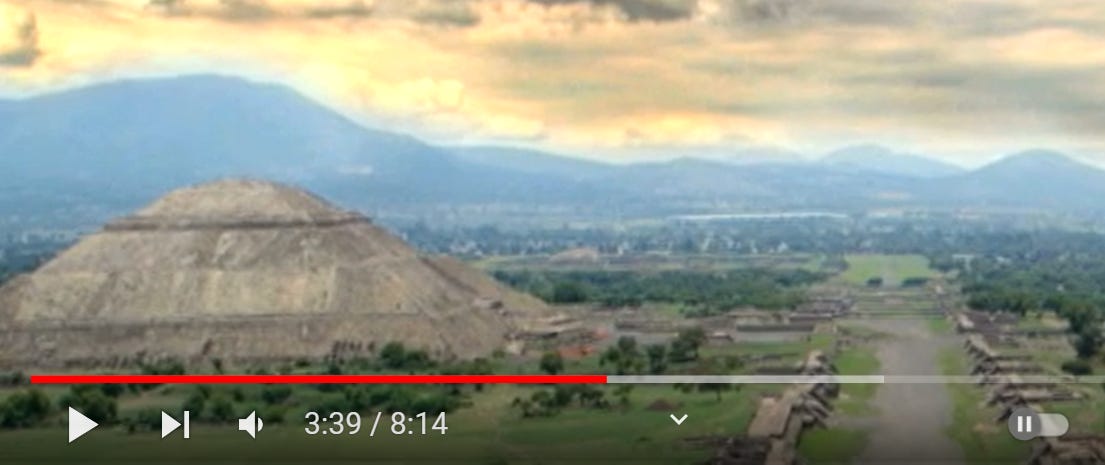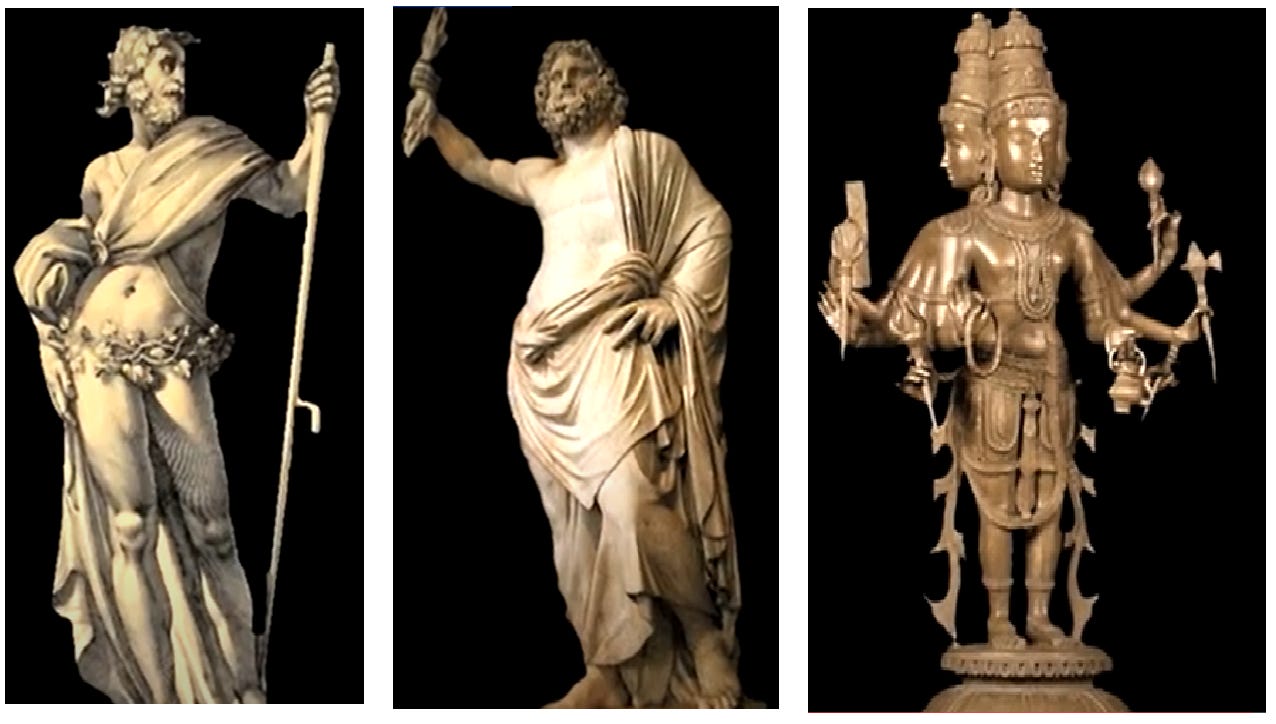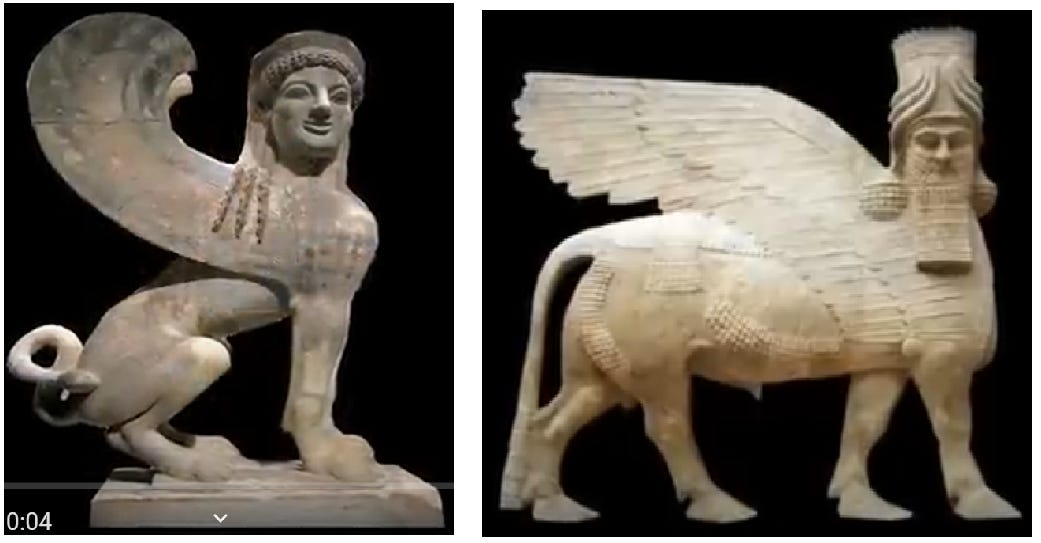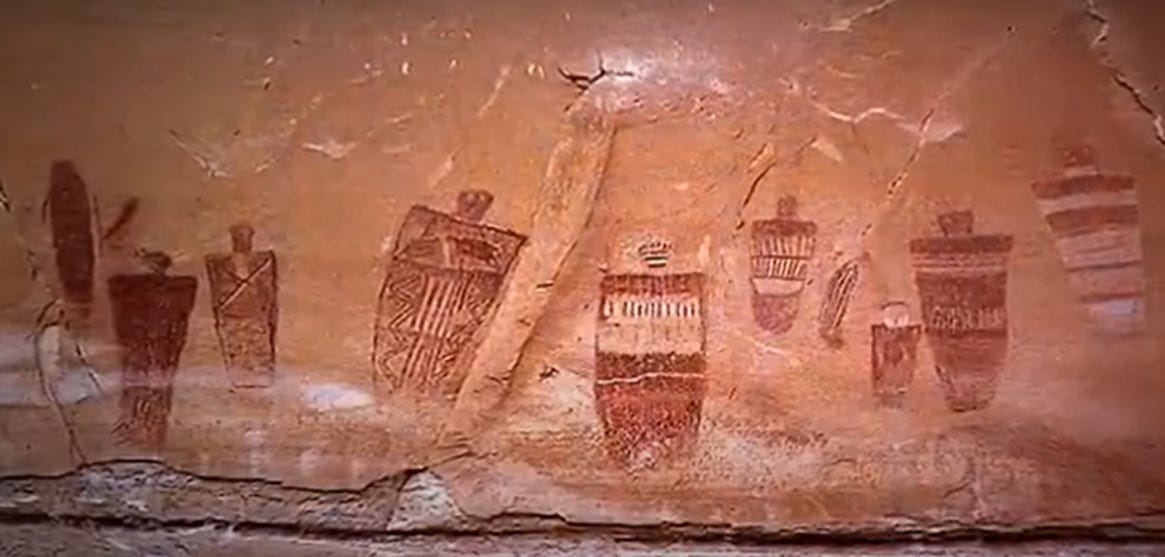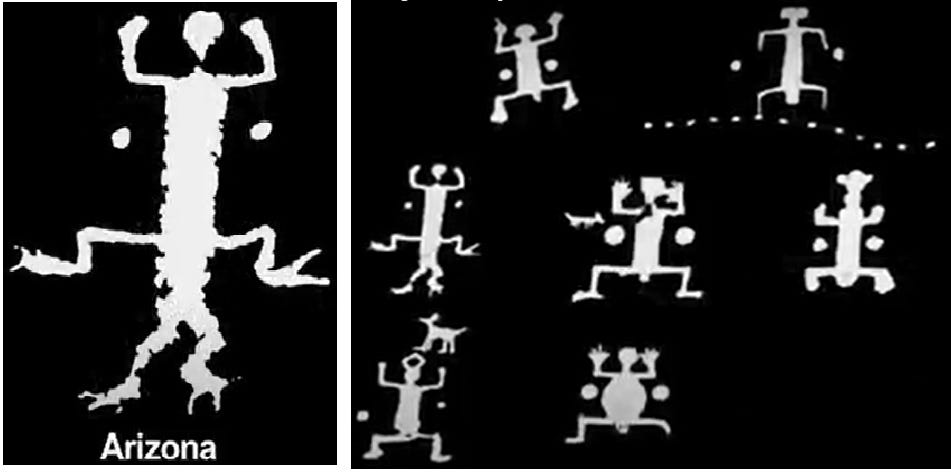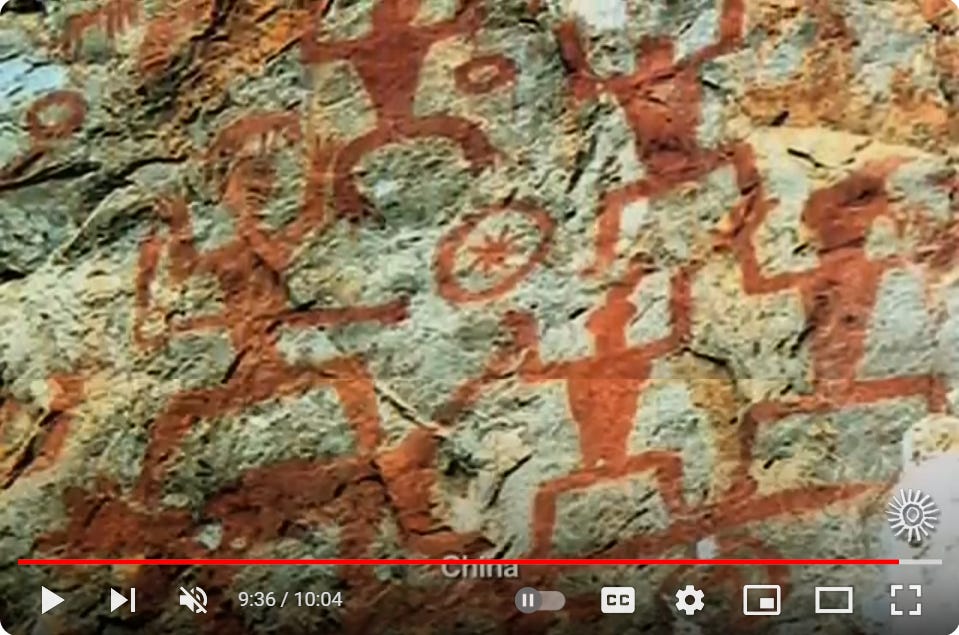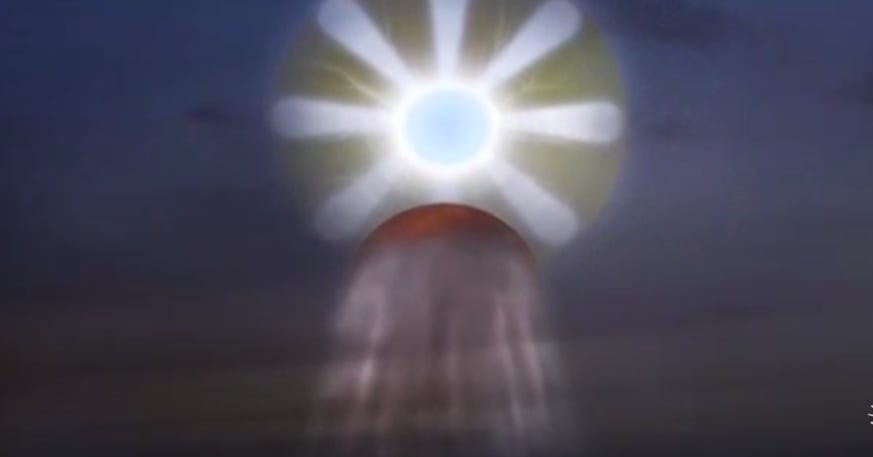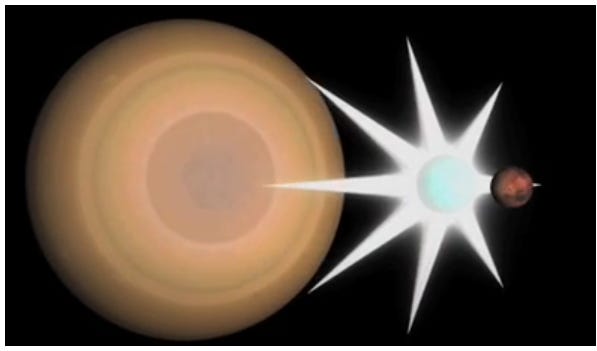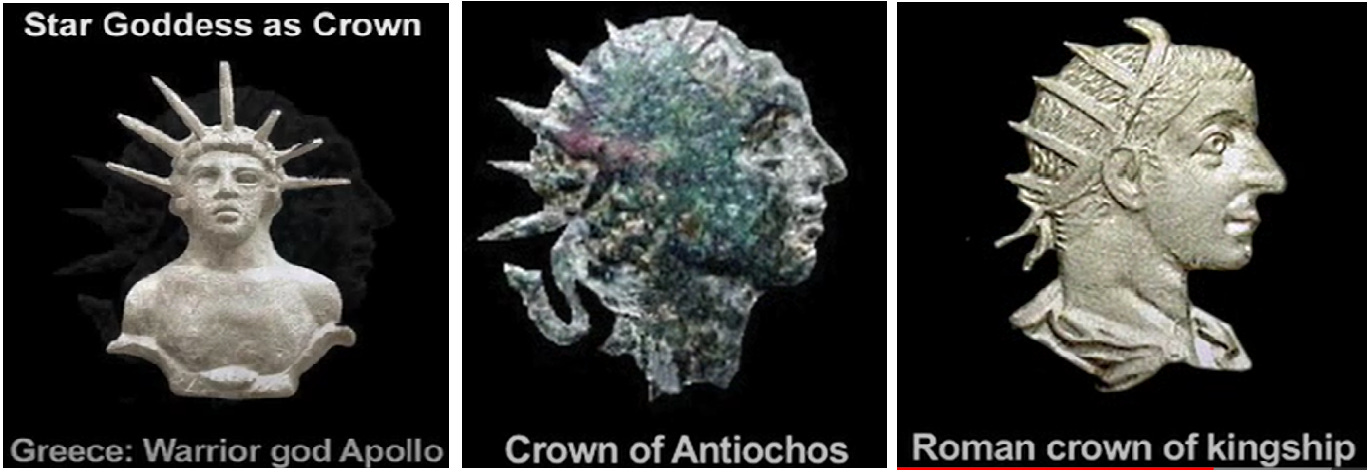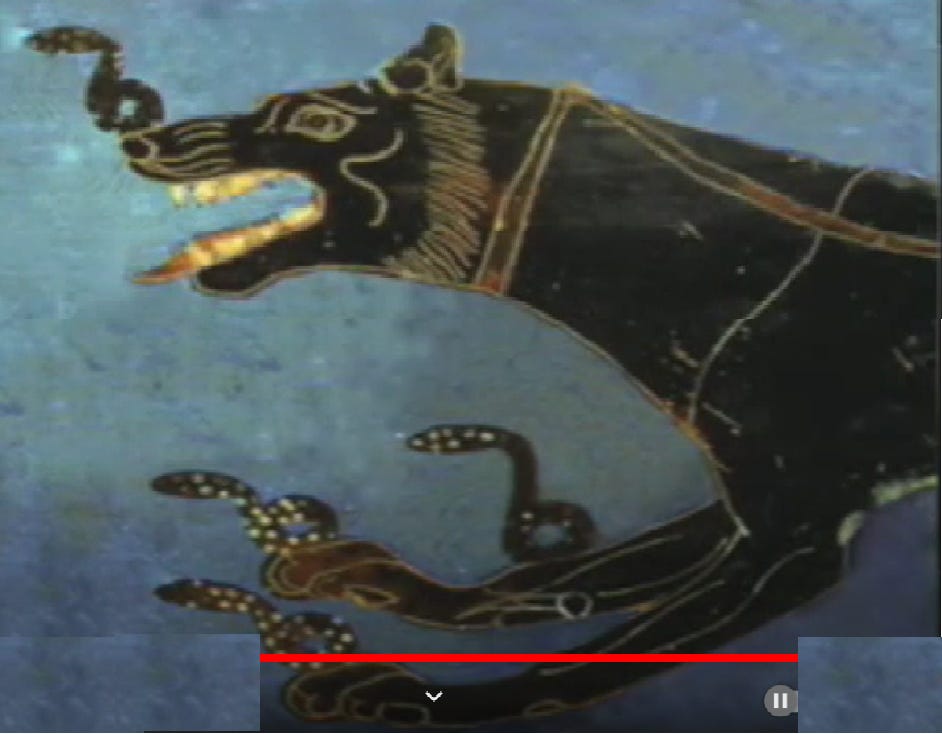I transcribed here 3 video clips from Symbols of an Alien Sky and a video on the Golden Age and Doomsday. This is part of my effort to figure out the timeline of ancient cataclysms and other ancient history. Ancient cave paintings in France are discussed briefly. I commented that those paintings must have been done after the Great Flood, but before the Younger Dryas event & Saturn Nova.
CLIP #1: Symbols of an Alien Sky
THE GODS WERE PLANETS
The dance of the planets is so regular and predictable, one might think they've moved like this forever. What a contrast to things claimed by the first astronomers of ancient Mesopotamia and numerous cultures that followed. They watched planetary motions with a compulsive fear. Why would diligent astronomers insist that the planets were the towering gods of a prior time? Planets ruled the destiny of kings and kingdoms. And they were the agents of doomsday, the end of the world. What was it about planets that inspired such reverence and fear? The Babylonian priest astronomer Berosus said that planets moving on different courses than today produced world catastrophe. In Greek, Roman and Gnostic thought, this was ekpyrosis, a catastrophic meeting of the planets. But the memory of planetary disorder is echoed by numerous ancient sources. Plato expressed it, and so did Zoroastrian texts, the Hindu Mahab Harata, Daoist teachings and the Chinese Bamboo books.
INTERDISCIPLINARY RESEARCH
Far from the spotlight today, researchers are exploring these questions of planetary history. They bring wide-ranging backgrounds, from comparative mythology to planetary science and plasma physics. All are asking if the solar system may have been unstable in the past, alive with electrical activity. Allow this question to be asked and the doors open to a new understanding of the past, of planetary history and the rise of civilization itself.
EARLY CIVILIZATIONS OF COMMEMORATION
The civilization most of us think of has new technology, economic advances, rapid communication, and expansive metropolitan vistas. But earlier civilizations were much different, and they pose a mystery yet to be resolved. Early civilizations were obsessed with the past. All looked back to extraordinary events, to an age of gods and wonders. All insisted that powerful gods ruled for a time, then went away.
Monumental cultures arose, and the monuments themselves meant much more than a display of technical skill. A monument commemorates something collectively remembered. It was obsessive acts of remembering that shaped the early civilizations, from the cities of Egypt stretched along the Nile, to those of the Fertile Crescent of Mesopotamia, from India to Southeast Asia and China,
and no less so in the Americas, from the early predecessors of the Aztecs and the Maya to the archaic cultures of the central Andes. All reveal a desperate urge to recover something lost. Egyptian priests called this lost epoch the age of the primeval gods.
THE GODS DEPARTED IN CHAOS
It began with the rule of an earlier sun god, Atum, who later departed. Cuneiform texts speak of the God An who ruled with terrifying splendor, then fled the scene. The Greeks celebrated the lost age of Kronos, but he, too, was replaced by another power, the towering Zeus.
Sages of India likewise remembered the rule of Brahma, though that god progressively faded into the background. So too, the Chinese Shangdi and Huangdi, the Aztec god and then Mayan Itzamna'.
All either departed for remote regions or faded from their original prominence. Through festivals and symbolic rites, the cultures remembered the lives of the gods. With every temple construction, every sacrifice, every harvest, every installation of a king, every royal marriage, every New Year Festival, the celebrants reenacted critical turns in the lives of the gods themselves. Were you to remove the stories of the gods, there would be no cultural content left in the early civilizations. Who were the gods and why did the early astronomers declare that the most powerful gods were planets? Here's a clue. The mythic accounts are punctuated by terror and cosmic violence. Urgent prayers and hymns reenacted the death through ordeals of great gods, recounting how one world age passed violently into another.
CLIP #2
THE MYTH-MAKING EPOCH
Several thousand years ago, events of beauty and terror provoked an explosion of human imagination. This was the myth-making epoch of human history. First came the enchanted realm, the theater of venerated gods and goddesses. The gods were prodigious.
The celestial habitat towered over the world, a model for temples and commemorative monuments on Earth. But the gods grew capricious. One celestial power metamorphosed into another.
Preposterous creatures never seen on Earth roamed the sky.
The gods turned violent, as heaven itself fell into chaos. Then celestial warriors and monsters appeared to battle in the heavens, wielded weapons of thunder and fire and stone. Our challenge will be to account for this outpouring of mythic content. The eminent psychoanalyst Carl Jung called these deep patterns the archetypes.
ARCHETYPES AS CLUES
He saw them as universal structures of the unconscious mind beyond rational or scientific explanation. Yet, the myths seem incomprehensible to us, but the archetypes offer a pathway through the confusion. They are the points of agreement between the far-flung cultures. And this agreement rises above the carnival of confusion and contradiction.
Every major culture remembered a cosmic mountain around which the heavens turned.
And every culture chronicled the terrible aspect of the Mother Goddess. Were there no common experience, the archetypal agreement would not even be possible. All that is required here is a willingness to meet the archetypes and without fear or prejudice or any advanced assumptions, to hear their message. The existence of hundreds of archetypes is a fact. And it is a fact as well, that no archetype speaks for natural events occurring today, not a single one. At the dawn of civilization, all of the archetypes were already present.
ABSURD ANCIENT IMAGES
Today we are fascinated by the monumental scale of the antique civilizations. But what were the essential memories that drove the monumental cultures so obsessively? The threads of evidence trace deep into the prehistoric past, a world barely recognized but not entirely lost. More than 10,000 years ago, Paleolithic artists painted these images on the walls of Lascaux Cave in France. {That cave painting was likely after the Great Flood, between 5,300 & 4,600 years ago, before the Golden Age, which came after the Younger Dryas events.} They were realists with an exceptional eye for detail. Why these talented artists of the Stone Age disappeared remains a mystery.
But the greater mystery is the epic that followed, and the change that Neolithic artists lost the ability to depict nature as we know it. Accurate representations of nature are present, but the dominant style produced a carnival of ghostly creatures and absurd forms never seen in our world. How did this tendency arise, not in one land alone, but on every habitable continent? Absurd, yes, but what provoked the distinctive patterns?
A stickman with no head, just a duck or other bird on his shoulders.
Hundreds of variations on this theme occur in the American Southwest. But the pattern doesn't end there. Notice the twin dots on the two sides of these crudely crafted stick figures. One instance alone is just a curiosity, but then widespread patterns must have an explanation. And other details only accent the irrationality.
PLASMA SKY
Recently, an answer to these mysteries came from outside traditional archaeology, from plasma science and laboratory experiments with electric discharge. Plasma scientist Anthony Peratt of Los Alamos Laboratories has shown that these stick forms recorded electrical events in the sky. Something like the Northern Lights we see today, but 1000 times more energetic.
And he matches the rock art forms precisely to the configurations taken by electric discharge in the laboratory. The rock art images are explained as sheets of intense electric current in the evolution of a plasma discharge. The central column you see in this stylized representation is the axis of the discharge. Wrapped around the axis is a torus or doughnut like tubular sheet of charged particles. The observer sees through the transparent formation, champagne glass above, squashed bell shape below. So the plasma density is greatest at the lens. Drawn in two dimensions, the formation matches the stickman, carved globally on stone by the thousands. The two dots under the stick man's arms are the exceedingly bright high energy radiation, called synchrotron radiation, emitted from the center of the torus. The current sheets continually warp as the electric discharge progresses and this form is not uncommon. A two-dimensional representation might look like this.
Peratt's work has shown that the stickman, the duck-headed version of the American Southwest, and variations from Hawaii to Saudi Arabia, is a plasma discharge formation, a subject in which he is an acknowledged world expert. His investigation is entirely independent from our own. Thousands of rock art images have enabled a supercomputer to identify formations as seen from different positions on Earth. The fit that he has documented cannot be accidental.
See this Video for more details on Plasma Formations
CLIP #3
COSMIC WHEEL
Amongst the greatest of enigmas was the Cosmic Wheel, recorded by every ancient culture. Images of a wheel in the sky carved on stone are older than civilization itself. Many archaeologists see these wheels as an imagined vehicle of the sun rolling across the sky.
But in its most common form, the cosmic wheel doesn't go anywhere. Often it rests on a stationary pillar, or atop a stairway, or a ladder, or as turned by a rope while resting on an altar or table. And the spokes of the wheel are not functional as such. They are fluid and etheric. Archaic gods and heroes hold a wheel in their hands. A cosmic wheel also served as the throne of gods and cultural heroes and wise men, symbolically replicated in the wheel thrones of kings on Earth.
The wheel throne of Buddha underscores our point. And even the popular footprint of Buddha recalls the same wheel in heaven. The inspiration did not come from our Sun. Compare these prehistoric instances of the pictographic wheel from Ireland and from California.
CONCENTRIC CIRCLES
Different parts of the wheel are clearly evident, a large circle or sphere, though not always present, a central star, and a smaller, darker circle or sphere inside the starlike form. The images do not depict a single object, but three objects, as demonstrated here, where the artist placed the small dark sphere well below the central star. I can assure you that the placements are not random.
These forms in the sky were planets in close congregation and immense above the ancient sky worshippers. You're looking at reconstructed images of a formation in the heavens just a few thousand years ago. The configuration evolved through many phases, evoking reverence and awe, a model for kings and kingdoms for thousands of years.
Great temples and cities and sacred mountains all pointed back to the mythic age of gods and wonders.
(Side view of Saturn, Venus & Mars when they were close to Earth)
(Front view of the planets next to an ancient depiction)
PLANETS WERE CLOSE TO EARTH
Let the world's first astronomers point the way for us. They knew that what the myths and hymns and prayers called gods were planets and aspects of planets. Planets appeared close to the earth in a heaven-spanning configuration. Memories about celestial splendor still surround us, even if humanity later forgot much more than it remembered. Reconnecting with our forgotten past will be essential. Essential for our own cultural integrity. Essential for the study of human consciousness. And essential for all of the sciences.
One simple truth will change the future of science and our understanding of human history. The ancient sky bore no resemblance to the sky we see today. Above human witnesses, planetary formations hovered close to the Earth. One electrical form metamorphosed into another, and the celestial dance of the mythic star goddess and the cosmic warrior, astronomically identified as the planets, Venus and Mars.
EYE, HAND, WHEEL, FIRE
Ancient observers saw the head of the warrior king wrapped in the radiance of the star goddess. It was his crown of glory and it was the warrior's magical protection, worn as a helmet or crest, but much more. The dancing Aztec God wore the rays of Venus as a crest, but also held the so-called half star Venus in an outstretched hand. And he even wore this protective radiance as his skirt. The theme is universal. The warrior's armor was the radiance of the great star, and that is the explanation for the unexplained radiant crown of kings.
As the forms of the configuration changed, the mythic interpretations changed as well. In pictures and words, the ancient chroniclers recounted the cosmic conjunction of the goddess and the warrior. The goddess was the eye, and the warrior was the pupil of the eye. The two spheres in alignment inspired a mythical interpretation as an eye and pupil inscribed upon the hand of God. The five fingers of the hand were the visible aspects of an 8-spoked wheel in a different phase. Buddhist symbolists knew that the hand bore a secret relationship to the 8-spoked dharma wheel. Buddha was the motionless axle of the wheel. And enthroned upon the hand of heaven, he was surrounded and protected by the celestial fire of the gods.
VIDEO #4
Golden Age & Doomsday
THE SATURN GOLDEN AGE
The natives of Surinam have a poignant memory of the lost epoch. In a time long passed, so long passed that even the grandmothers of our grandmothers were not yet born, the trees were forever in fruit, the animals lived in perfect harmony, and the little agouti played fearlessly with the beard of the jaguar. For the Hindus, this was the krita yuga, or perfect age. ... The Chinese called it the age of perfect virtue. ... It was paradise. The Garden dates to the first expressions of civilization. According to ancient Greek poets, philosophers and historians, the present age is just a shadow of the former epoch, called The Golden Age of Kronos. But who was this ancient God Kronos? All Greek astronomical traditions agree that Kronos was the planet Saturn. Our own name for the planets came from the Romans. In unison, Roman poets and historians insisted that in a former time Saturn had ruled as a god king, producing a paradise on Earth. It would be almost impossible to overstate the power of this memory among the different cultures. For the Babylonians, the Hebrews and the Greeks, the most sacred day of the week was the Sabbath, a ritual remembrance of the lost epoch. And in each of these cultures, this holiest day was the day of Saturn. The Latin Saturni dies, the Celtic day of Seter, our Saturday.
DOOMSDAY
But the Golden Age did not last. In the myths of Quetzlcoatl, of Ra and of Baal, Kronos and of Saturn, the Golden Age does not just come to an end, it ends violently. And with the collapse of the Golden Age arrives the fear of Comet, the Dragon of Darkness, the fall into the cosmic night, the clash of the Titans, all of the symbols of Doomsday. Stars of heaven falling into the void, the land is on fire, the mountains crumble and rocks explode in flame. All the rivers and seas overflow and sweep across the Earth. ... With the Old Norse poem Voluspa recalls the great catastrophe of Ragnarok, the twilight of the gods, when the terrifying wolf, Fenris, it's jaws reaching from heaven to earth, brought forth a brood of howling wolves, and the Sun became blood-red and vanished. And the world slipped into a winter lasting for years. Icelandic, Aztec, Babylonian, every ancient culture seems to have remembered an event called The End of the World.



